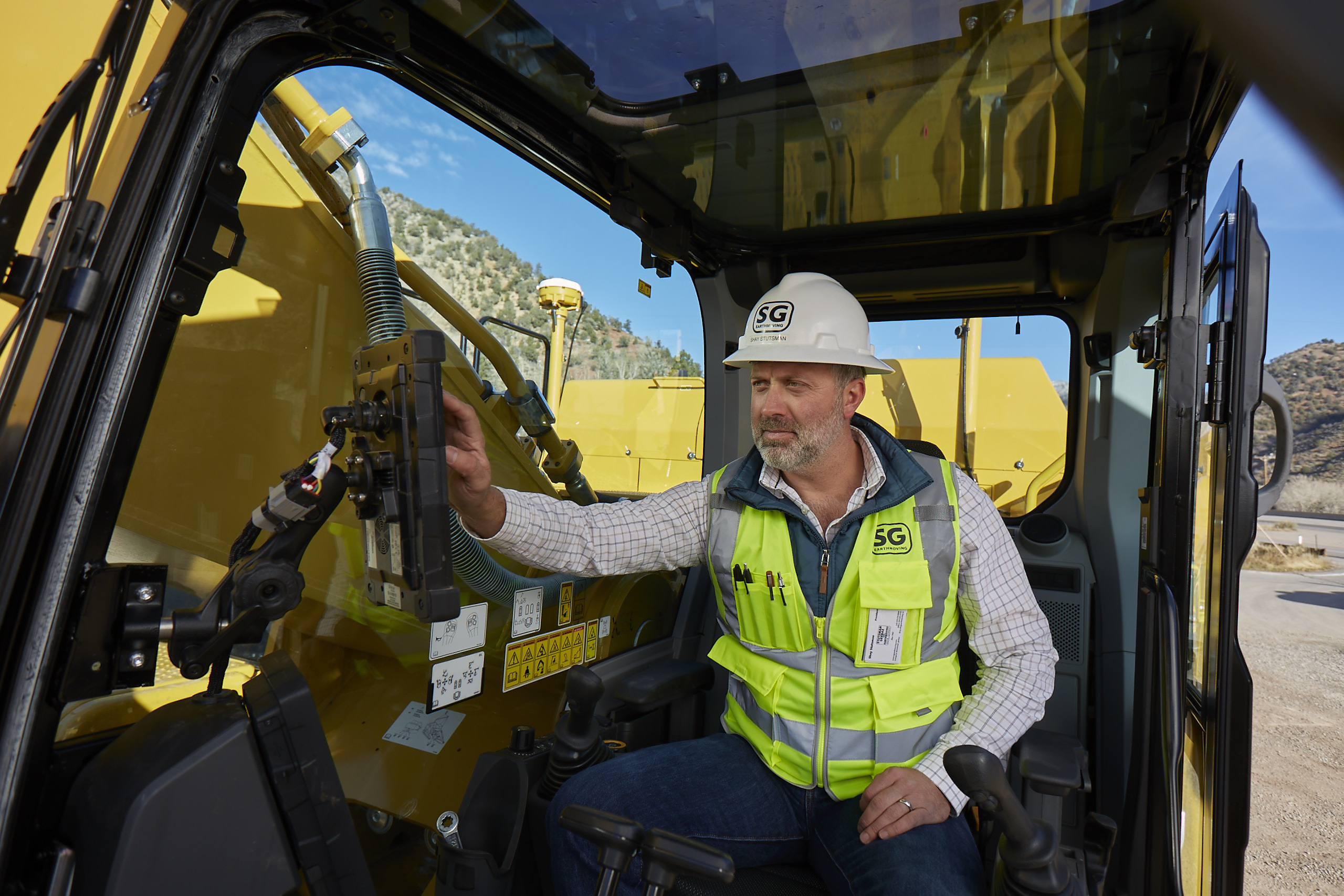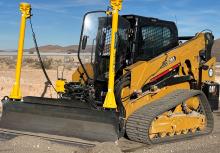
Shay Stutsman knows the importance of construction technology, including the grade control solution he uses in the field.
“We’re able to do more work in less time, with greater accuracy, while keeping our indirect expenses the same or even lower,” said Stutsman, the president of Stutsman-Gerbaz, an earthwork and demolition contractor in the Roaring Fork Valley of Colorado.
Technology is essentially becoming a must in the construction industry. Increasingly, a contractor can’t even bid on a project without utilising some form of technology – not to mention the benefits it brings to the jobsite.
“It can help address machine and operator efficiency, asset and fleet management, and site productivity, in a simple solution,” said Jefferson Yin, who heads new business models & commercial intelligence for Volvo Construction Equipment’s North American region.
But the technology is expensive to purchase. This has led manufacturers, such as Volvo CE, and data-driven businesses such as Trimble and Topcon, to offer their technology on a subscription basis.
Instead of making an expensive, one-time purchase, contractors pay a flat fee on a monthly basis. “It eliminates that sizeable upfront capital investment and definitely allows us to make better business decisions,” Stutsman said.
Typically included is a full factory warranty and repair/replacement of accidentally damaged hardware – a big plus in the construction world, where equipment can take a beating.
Making a dent
Subscriptions are just beginning to make their way into an industry where ownership is the preferred business model.
Topcon started offering subscriptions for software and services in 2012, said Jason Hallett, the company’s vice president and general manager of integration services. The monthly payments originally centered on product maintenance and real-time kinematic (RTK) corrections.
“We then moved onto a service offering that included the application, product updates and web services bundled together,” he said. The service offering, which offered a lower price point than the outright purchase, was paid for monthly. A subscription was born.
Customers are taking advantage of the range of options, Hallett said. “We’ve seen continual adoption of subscriptions and services.”
He attributes this, in part, to businesses outside of the construction industry, such as software companies like Microsoft, switching from one-time purchases to subscriptions. “It’s not so foreign in our work lives anymore,” he said.
Trimble dealers, who are leaders on the issue, have seen as much as 20% of their business move to subscriptions, said Elwyn McLachlan, senior vice president in the civil infrastructure sector. About 90% of Trimble dealers in the U.S. have sold at least one subscription – and many have sold substantially more, said Toni Piwonka, associate vice president, strategic transformation at Trimble.
Equipment manufacturers entered the subscription realm much earlier. “Most of our digital solutions are offered through a subscription,” said Yin of Volvo CE. “It’s a growing trend in the industry from an equipment acquisition standpoint. More and more customers are looking for solutions that minimise ownership risks and lower the up-front investments.”
A new way of thinking
Historically, construction firms have preferred to own their equipment, McLachlan said.
“If you know these construction companies, many of them are family businesses,” she said. They often look at their annual profitability and then decide how much they can purchase. “A lot of construction companies operate that way,” she said.
It might be time for a change in that thinking. Heavy equipment is an asset, but software is not, McLachlan said. “Sometimes I can't help but say to people, ‘You know with software, you never really owned it.’”
The “owner” might have made a single payment, but they never had the rights to the software, McLachlan said. And it’s not much of an asset, with hardware and software quickly becoming outdated.
Creating comfort
Piwonka said that changes in the construction industry are pushing businesses to adopt the technology – and that, in turn, is leading some to explore subscriptions.
“It’s another way that we're meeting customers’ needs,” she said. “We are getting some customers saying, ‘We want more flexibility in how we pay and when we pay.’ They’re looking for more creativity from us, and subscriptions are a way we can meet that need.”
A subscription removes some cost concerns, which ultimately puts the technology in more hands.
“Partly, it's a way that we can attract new technology customers,” Piwonka said. “Often, they're a little bit resistant at first. But once they try our technology, they're sold.”
The “try” component is the key. “A subscription is a great way to do that,” Piwonka said. “You can offer a very basic, entry-level subscription and get the customer comfortable with that and then offer additional technology through upgrades.”
Hallett agreed that these offerings are speeding adoption. “I think it does help with adoption by enabling new functionality and services, while also lowering the initial capital outlay,” he said.
A subscription can essentially function as a testing tool, Yin said. “It enables us to offer customers a demonstration so that they can really learn about and experience the benefits,” he said. “This helps them to make an informed decision.”
The final decision is all but certain to be the continued use of this technology. “The efficiency gains are visible, and the feedback from managers and operators is very positive when it comes to how these solutions make their daily routines easier,” Yin said.
What tech tools are being used?
Available solutions include everything from grade control systems on the machine to free-standing base stations, data collectors and rovers.
Topcon’s subscription alternatives are primarily field software applications and web services like Sitelink3D for data transfer and remote support. Also offered are RTK correction services and an integration platform that expedites work between different contractors.
In terms of a specific product, Topcon’s MC-Mobile solution is drawing small businesses because the price to enter and the learning curve have both been substantially reduced, “which makes this technology more accessible than ever to smaller operations,” Hallett said.
“As we go into the future, more options for hardware as a service, or everything as a service, will open this part of the market for adoption of more advanced technologies,” Hallett said.
McLachlan reports that bases and robots are the most common technology for those just starting on machine control. “A lot of the early adopters of the subscription offerings started experimenting more with a base and rovers because they’re easy to deploy and easy to move around,” she said.
Available in the U.S. and Canada, the Trimble Works Plus subscription includes upgrades to the latest hardware and software, a full factory warranty and repair or replacement of accidentally damaged hardware. The plan supports a wide range of needs for most any contractor.
Volvo CE customers are able to monitor their fleet and optimise their site productivity with the company’s digital solutions. In addition, customers can increase uptime through proactive monitoring, which is sold as a subscription.
Some features of Volvo CE technologies allow for office-to-operator and operator-to-operator communication and machine speed limit control, which directly improve site safety and efficiency.
“We have solutions that cover both big and small operations,” Yin said. “Some are more focused on overall site productivity and others on equipment maintenance and uptime. We are seeing growing demand across both large and small businesses.”
Advantages for larger contractors
Specs for large-scale infrastructure projects often require the use of technology. Bigger contractors that were already familiar with, and previously owned, the technology are turning to subscription-based plans instead, according to Piwonka and McLachlan.
These projects are typically handled by one or more larger contractors. Because technology is a must for the projects, subscriptions make it easy for the partners to share technology and divide costs between them.
“That’s a really great place for subscriptions, because you can align the subscription term and the plan with the job,” McLachlan said. When the project is completed, there is nothing of a residual value to divide among the contractors involved, making the split clean.
Contractors on these large-scale jobsites are increasingly coordinating their efforts through technology, Hallett said. Subscriptions put all contractors on the same page.
“Most of the systems Topcon produces come with a subscription option that enables the utilisation of connected and integrated web services,” he said. The services provide multi-source data automations that connect to partner technologies.
“This enables benefits such as automatically delivering design models and tasks to machines based on the construction schedule. I think this shows that the jobsite is becoming more digital every day,” Hallett said.
Smaller contractors see benefits, too
The market is driving adoption on smaller projects, too. Contractors need the technology to boost productivity and efficiency and, ultimately, improve their bottom lines. Sometimes the technology is a prerequisite to work as a subcontractor.
Given the need, smaller contractors are using the subscriptions as a way to enter the realm. “There are smaller contractors that didn't have the cash but they're really happy to have the technology at a lower cost,” Piwonka said.
For these businesses, it’s about lowering the barrier to entry and getting comfortable, McLachlan said. Many start with a machine control system and are quickly impressed by the technology, leading to the use of additional tools.
What is the definition of a subscription business model?
The subscription business model is a strategy which encourages people to pay a recurring price at regular intervals to access a suite of relevant products and services. There is no one-time purchase … the subscription model focuses on giving its clients ongoing value via long-term relationships. It’s all about convenience, customization, continuity, and long-term predictable pre-agreed costs. Magazine, book, and newspaper publishers have sold via subs for years, but today the concept is everywhere from software apps to streaming services like Netflix, Amazon Prime, iTunes, and Disney+. Consumers used to buy music and movies on LPs, CDs, DVDs and tapes … and own a limited “library” of things to listen to or watch. Today, they subscribe to services like Spotify and get immediate access to millions of songs. The subscription model only works if the suppliers invest heavily in customer service, product quality, and user experience. The win-win is a compelling value proposition … regular pre-set monthly fees, easy access to the best products and services that the market can offer, no depreciation worries for the user, and a much more efficient industry.
Staying current
A key benefit of a subscription is access to the frequent updates, these experts said.
“One of the advantages of a subscription is to stay current with the technology because the technology is moving much faster,” McLachlan said. A construction equipment manufacturer might overhaul the machinery line every five years, she said. Compare that to Trimble’s development cycle for the technology, which includes upgraded capabilities or new components several times per year.
Because updates are included, subscriptions ensure all machines in a fleet are on the same version of the technology. “They don't have to worry about version control,” Piwonka said. “Standardisation is definitely a customer benefit for the bigger operations.”
Frequent updates will continue as the field evolves and AI makes its way onto the scene.
Rental houses provide technology
Rental houses now offer all kinds of technology, including survey, layout and machine control, Hallett said. This creates great opportunities – and great challenges – for the providers.
The technology has to be accessible for short-term rental periods and across varied users. It has to be compatible on the particular jobsite and account for the customer’s preferred experience, he said.
“You’ll notice today that most applications are starting to require registrations and accounts directly with the manufacturers and require user logins to the applications,” Hallett said. “This is so that the manufacturer can deliver individual experiences regardless of where they log in from.”
Piwonka describes the rental industry as “an interesting and growing market” for subscriptions. Rental houses previously purchased the technology and provided it to their customers. “They are looking at subscriptions as a way to do that easily,” she said.
McLachlan sees subscriptions as cost-management tools for the rental house and the end user. “Every machine on the lot can affordably be equipped with the technology, which increasingly is used by rental customers,” she said.
Volvo CE technology is used by rental houses, making subscriptions a natural next step. “Many rental houses use our services to monitor their fleets,” Yin said. “They may extend this to their customers when it’s a longer-term rental.”
A flexible future
What does the future hold? Perhaps even more payment flexibility.
“We’ve even introduced a fourth model, which is a pay-for-what-you-use model,” Hallett said about Topcon’s selection of options. It can address seasonality or provide temporary access to a technology that is not consistently needed.
Having said that, the primary focus is continuing to integrate services and improve the customer experience.
“Continuous value delivery is key, and with modern approaches and greater connectivity, it is more possible today than ever,” Hallett said.
Digitalisation will only expand, so it makes sense to continue to use subscriptions to access that technology. “Volvo CE truly believes in this business model and will continue to develop new digital solutions to help our customers be successful,” Yin said.










